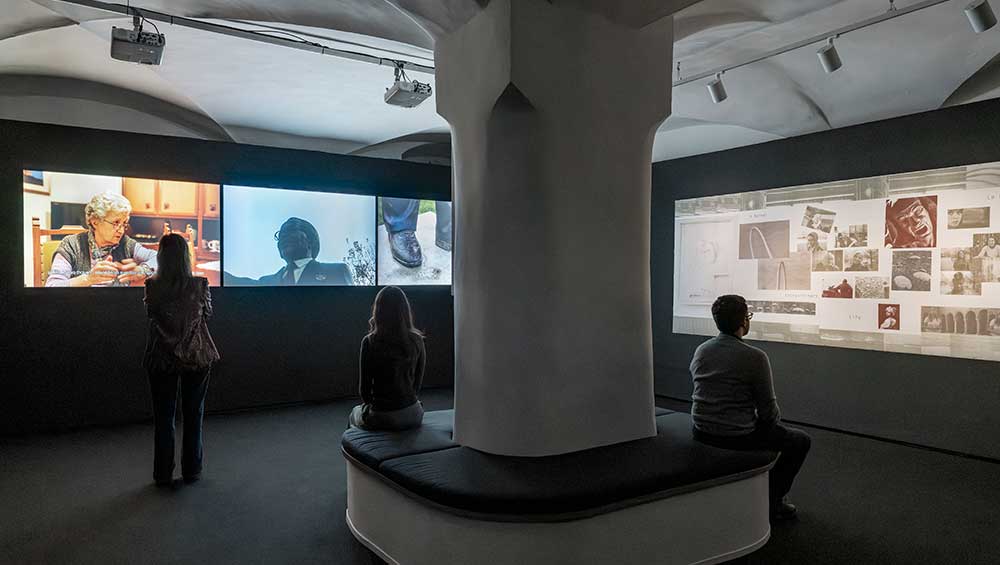
Helen Cammock, installation view, Time for Women! Empowering Visions in 20 Years of the Max Mara Art Prize for Women, Firenze, Palazzo Strozzi, Strozzina, 2025. Photo: Ela Bialkowska, OKNO Studio. Courtesy Fondazione Palazzo Strozzi, Firenze.
Palazzo Strozzi, Florence
17 April – 31 August 2025
by JOE LLOYD
The Max Mara Art Prize for Women is a biennial prize for artists based in the UK who identify as women. Established in 2005 by the eponymous fashion group, it offers winners a sort of modern-day Grand Tour: a six-month residency across various locations in Italy, many of them off the beaten track. These residencies all focus on acquiring a new artistic skill, such as learning a traditional craft. The new work is then exhibited at Whitechapel Gallery in London and Collezione Maramotti in Reggio Emilia, the museum that houses the collection amassed by the Max Mara founder, Achille Maramotti. These exhibitions have often served as the first major institutional solo show for these artists. Many have gone on to further success.

Dominique White, installation view, Time for Women! Empowering Visions in 20 Years of the Max Mara Art Prize for Women, Firenze, Palazzo Strozzi, Strozzina, 2025. Photo: Ela Bialkowska, OKNO Studio. Courtesy Fondazione Palazzo Strozzi, Firenze.
Works from the first nine prize winners have now been brought together for Time for Women!: Empowering Visions in the 20 Years of the Max Mara Prize for Women in the labyrinthine underground tunnels beneath Florence’s Palazzo Strozzi. Some of their exhibitions have been reproduced in full, others excerpted. Twenty years is a long time in contemporary art, and the nine artists so far honoured loosely reflect some larger trends. It began with two artists working in film, Margaret Salmon and Hannah Rickards, who won in the video art obsessed 00s. More recent winners Emma Talbot and Dominique White, on the other hand, reflect our decade’s return to materiality and making: Talbot’s installation is surrounded by paintings on silk, while White’s sculptural works are created using rough industrial techniques.
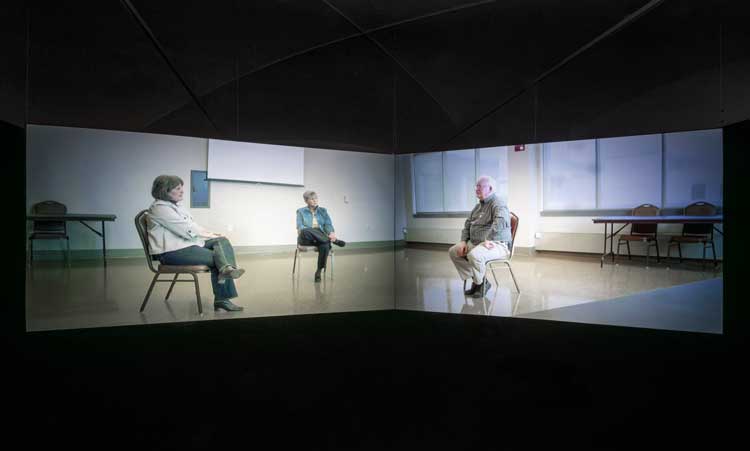
Hannah Rickards, No, There Was No Red, 2009, installation view, Time for Women! Empowering Visions in 20 Years of the Max Mara Art Prize for Women, Firenze, Palazzo Strozzi, Strozzina, 2025. Photo: Ela Bialkowska, OKNO Studio. Courtesy Fondazione Palazzo Strozzi, Firenze.
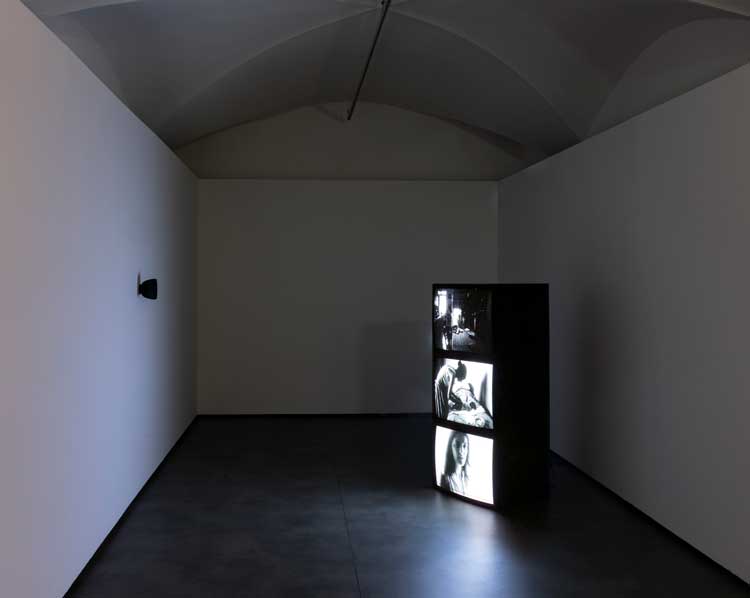
Margaret Salmon, Ninna Nanna, 2006, installation view, Time for Women! Empowering Visions in 20 Years of the Max Mara Art Prize for Women, Firenze, Palazzo Strozzi, Strozzina, 2025. Photo: Ela Bialkowska, OKNO Studio. Courtesy Fondazione Palazzo Strozzi, Firenze.
Contemporary art’s recent fixation on unearthing personal and collective histories is a near-constant throughout the exhibition. The march of time also shows the prize gradually defining itself. The scale has grown, from single works to entire collections. Salmon produced the three-channel film Ninna Nanna (2006), here compressed into a column of televisions. Some later contributions sprawl across an entire room.
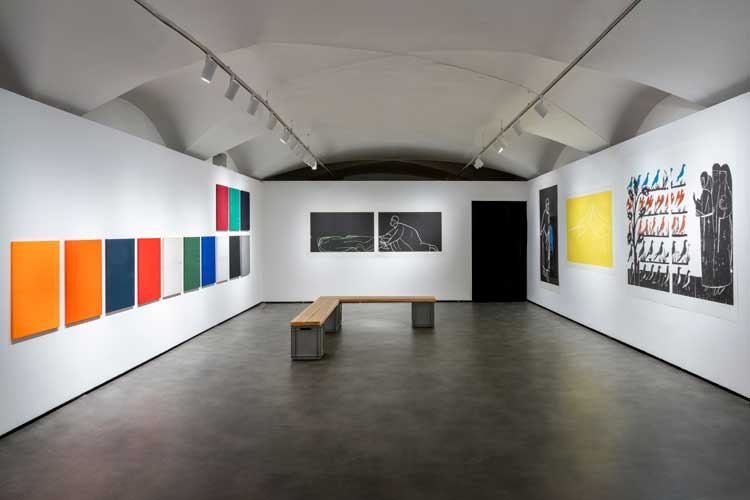
Andrea Büttner, installation view, Time for Women! Empowering Visions in 20 Years of the Max Mara Art Prize for Women, Firenze, Palazzo Strozzi, Strozzina, 2025. Photo: Ela Bialkowska, OKNO Studio. Courtesy Fondazione Palazzo Strozzi, Firenze.
With the exception of Rickards’ earlier outlier – the split-screen video No, There Was No Red (2009), which features people discussing an alleged superior mirage seen over Lake Michigan – the art produced tends to reflect the Italian residency. White’s shipwreck-resembling sculptures in part relate back to Christopher Columbus, the Genoese sailor who jumpstarted European colonialism. The German-born Andrea Büttner knits together Italy’s monastic tradition with arte povera. Perhaps the most formally interesting work here is her Untitled (Paintings) (2011) series, which features fabric from working-class uniforms stretched across canvas so that they become akin to abstract paintings. Elsewhere, there are references to commedia dell’arte, Faenza ceramics, a Gustav Klimt painting housed in Rome, Tuscan lullabies, and the sensory overload of a summer holiday on the peninsula.
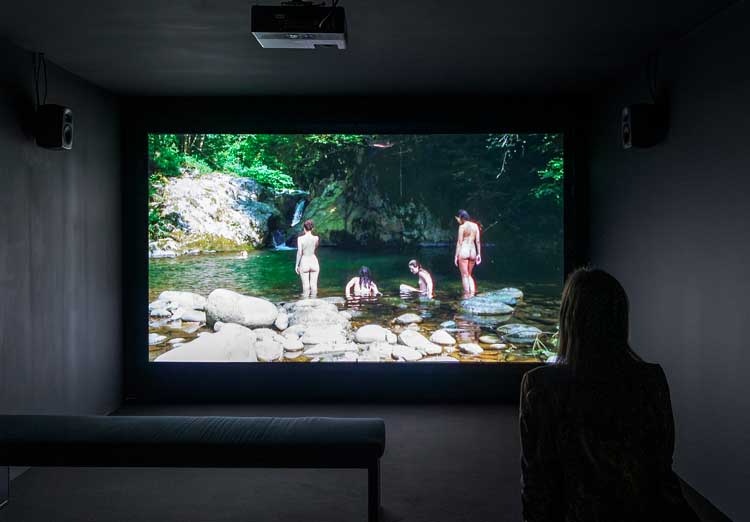
Laure Prouvost, Swallow, 2013, installation view, Time for Women! Empowering Visions in 20 Years of the Max Mara Art Prize for Women, Firenze, Palazzo Strozzi, Strozzina, 2025. Photo: Ela Bialkowska, OKNO Studio. Courtesy Fondazione Palazzo Strozzi, Firenze.
This last is the subject of Laure Prouvost’s film Swallow (2013). This was originally shown within a pavilion-like structure that blunted the fervency of the video. Now displayed alone, the film offers a relentless barrage of pleasurable scenes. Nude bathers frolicking in a secluded pond, a fish eating a raspberry, a fig crushed against a body, a butterfly resting on battered trainers. Prouvost lingers on each image briefly but often loops back, capturing the viewer in her glittering net. The sense of pleasure is conveyed to the viewer not through these images themselves but the way they link together and succeed each other. They are fleeting like memories. The footage is punctuated by a vast mouth breathing, inhaling and suffocating on the beauty. Prouvost’s faux-naif voiceover sounds overcome by the sensorial overload.
Prouvost’s lagoon seems a secluded place for women, at least until a handsome man intrudes, an Actaeon stumbling upon Diana’s grove. Several of the other artists explore feminine spaces, whether actual or metaphorical. Helen Cammock’s 80-minute film Che Si Può Fare (2019) is a document of conversations with diverse women while travelling the country, including nuns, refugees and anti-fascist partisans. It has a diaristic quality. Stories are juxtaposed with musical performances, in particular of a pre-operatic lament by the baroque composer Barbara Strozzi. Despite being about the lives of others, it feels a personal endeavour. Music also ties together Salmon’s Ninna Nanna, which shows three Italian mothers going about their daily lives, linked by their recitation of the Tuscan lullaby Ninna Nanna Fiorentina. It homes in on the individual lives of its subjects like a neorealist film.
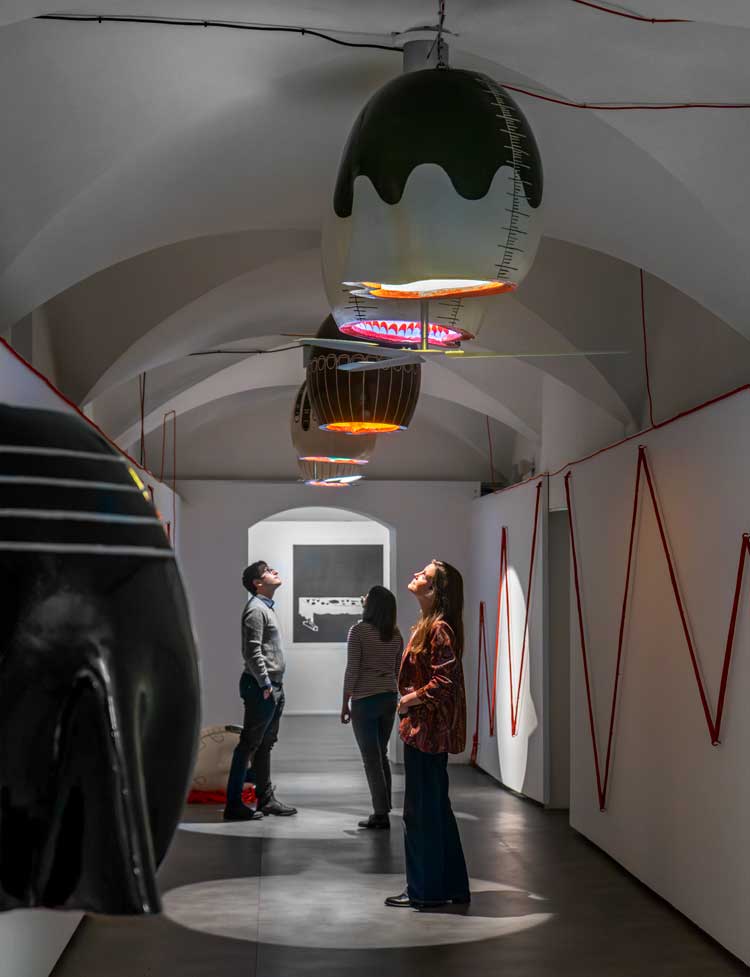
Emma Hart, Mamma Mia!, 2017, installation view, Time for Women! Empowering Visions in 20 Years of the Max Mara Art Prize for Women, Firenze, Palazzo Strozzi, Strozzina, 2025. Photo: Ela Bialkowska, OKNO Studio. Courtesy Fondazione Palazzo Strozzi, Firenze.
Others take a more indirect approach. Emma Hart’s Mamma Mia! (2017) is a sequence of ceramic vessels, most hung as pendant lamps. Some of them resemble both cartoon heads and measuring jugs. A fan beneath one of the heads has cutlery for arms. They place us in a sort of spectral kitchen, a site where dynamics unknown to us play out.
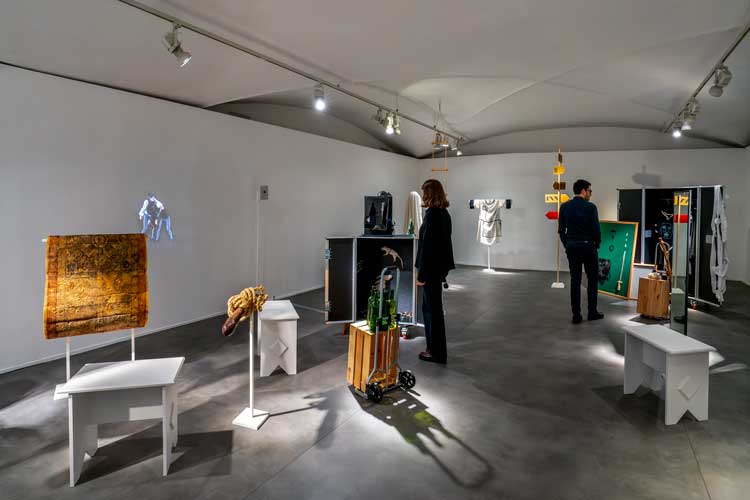
Corin Sworn, Silent Sticks, 2015, installation view, Time for Women! Empowering Visions in 20 Years of the Max Mara Art Prize for Women, Firenze, Palazzo Strozzi, Strozzina, 2025. Photo: Ela Bialkowska, OKNO Studio. Courtesy Fondazione Palazzo Strozzi, Firenze.
Ghostliness also emerges from Corin Sworn’s Silent Sticks (2015), an assembly of costume, props and other handmade objects that sprawls across a room as a controlled chaos. While voices narrate the story of the 16th-century French imposter who claimed to be Martin Guerre, we can fixate on objects that reference the role-playing and disguise-filled commedia dell’arte. Are these the traces of a vanished life or the making of one?
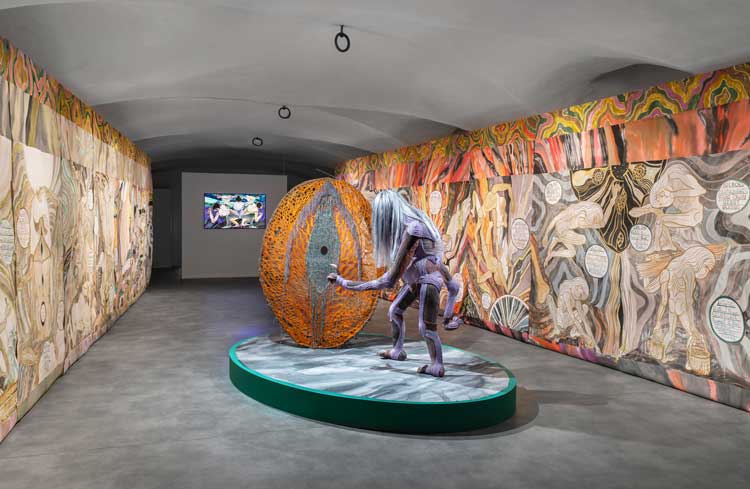
Emma Talbot, The Age, 2022, installation view, Time for Women! Empowering Visions in 20 Years of the Max Mara Art Prize for Women, Firenze, Palazzo Strozzi, Strozzina, 2025. Photo: Ela Bialkowska, OKNO Studio. Courtesy Fondazione Palazzo Strozzi, Firenze.
Talbot’s installation The Age (2022) shows a fundamentally different approach to storytelling. A central sculpture reimagines an elderly woman from Klimt’s The Three Ages of Woman (1905) as a hero. This is surrounded by painted silk panels and an animation that imagines this figure facing the labours of Hercules. Rather than killing and capturing like the hero, Talbot’s totem instead helps these mythical beasts to accept themselves. The panels are covered in inspirational quotes – “Use and value diversity”, “could you rethink value produce no waste” – that a few years ago I might have greeted with a raised eyebrow, as too direct, the message overwhelming its medium. But today Talbot’s messages, scrawled like a mental notes-to-self, embody vital values that cannot be taken for granted.